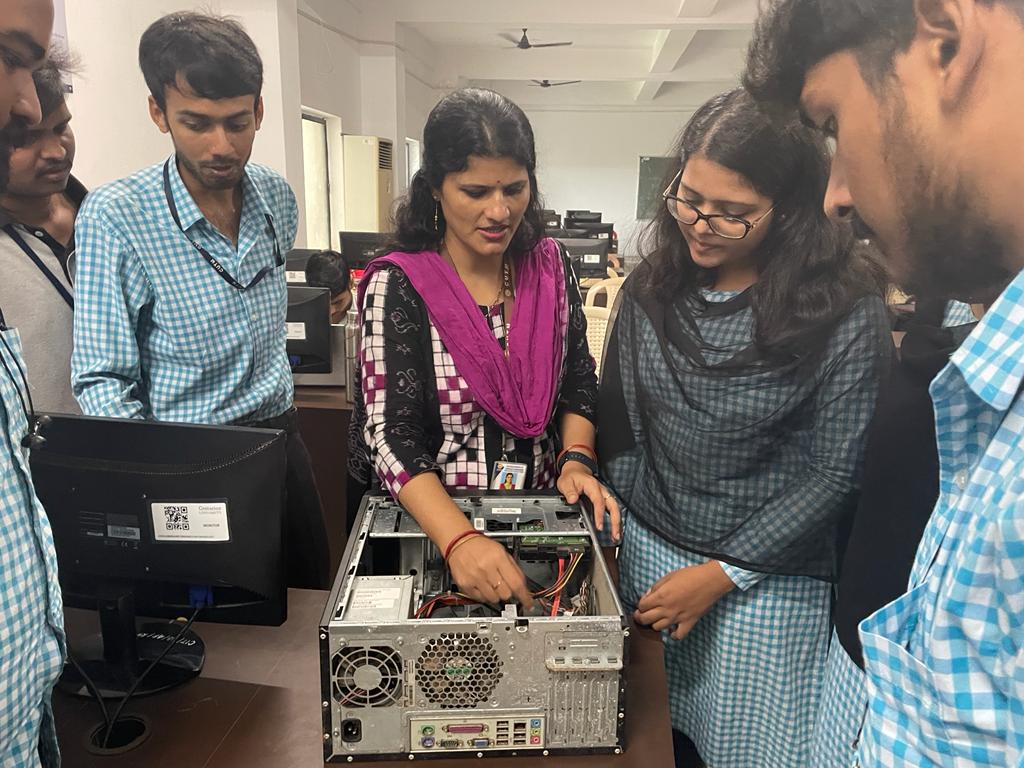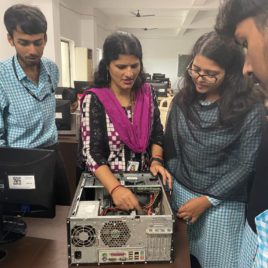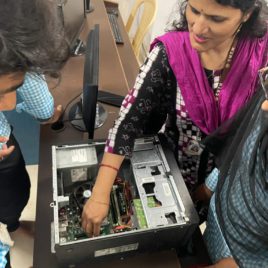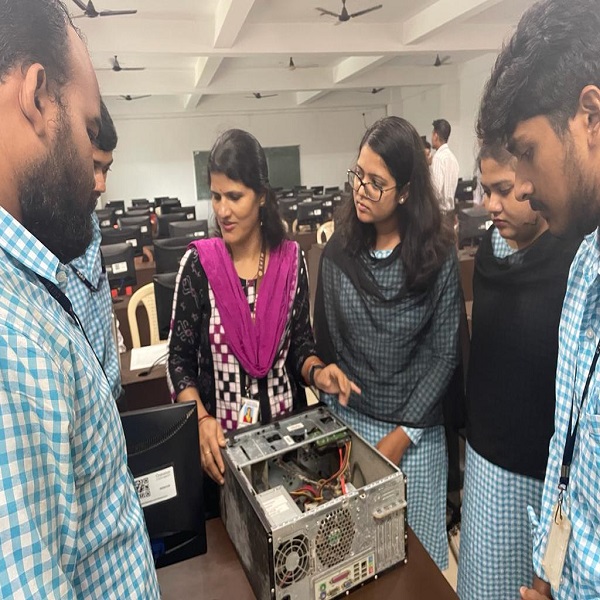This course is about the basics of electrical and electronic components related to the hardware and networking system. It teaches to assemble and repair desktop PC with all its internal components, along with making the learner to be able to install different types of operating system and all other application software, customization of OS, updating device driver, setting firewall security, junk file removal, data backup and data recovery techniques. Assembling and repairing Laptop PCs and its internal hardware components is also a part of this course.
Computer Installation & Maintenance
Computer Installation & Maintenance
Course Attendees
Still no participant
Course Reviews
Still no reviews
Code(Credit) : CUTM3120 (0-3-1)
| Scheme | CRAFTSMEN TRAINING SCHEME (CTS) |
| NSQF Level | 4 |
| Duration | 1 Year |
| Sector | IT & ITES |
| Occupations | Design and Installation |
| Entry Qualification | Passed 10th Class examination with Science and Mathematics or its equivalent |
| Minimum Age | 14 years as on first day of academic session. |
| Aligned to (QP) | https://www.cstaricalcutta.gov.in/images/CTS%20CHNM_CTS_NSQF-4.pdf |
Course Objectives:
The objectives of this subject are:
- Familiarization to the principles, materials, and tools required for computer system installation and maintenance
- Develop an end-to-end technical understanding
- Complying to the industry specifications, guidelines and safety standards during work
After completing this program-
- Assemble and repair Laptop and Desktop Computer with all its hardware components.
- Install and customize different Operating System and all other application software.
- Perform the operations of office package (word, excel, power point).
- Install Printer, Scanner and troubleshoot their faults.
- Set up and configure Networking System using various network devices.
- Browse internet and communicate through email.
- Can join industry as Technician and will progress further as Senior Technician, Supervisor and can rise up to the level of Manager.
- Can become Entrepreneur in the related field.
- Can join Crafts Instructor Training Scheme (CITS) in the trade for becoming an instructor in ITIs.
Learning Record:
The trainee will submit a Practice/Project/Learning record after each class/session.
Assessment Process:
- The assessment agencies should have an expert to conduct assessment NOS wise and every trainee should score a minimum of 70% in the overall assessment.
- The assessment of the theory/knowledge will be based on a written test/viva-voce or both while the skill test shall be hands-on practical.
Course Syllabus/Contents:
Module 1: Computer System Fundamentals
Characteristics and Limitations of Computer, Main components of computer system, Identify the Input/output devices: Types of input devices – Text input devices, Pointing devices, Audio visual input devices, Input card readers, Input Reading Text / Codes, Input Sensors, Types of output devices, Soft copy output devices -Monitors, LCD, LED monitors, Hard copy output devices -Printer, plotter, Audio output devices, To understand the colour coding for the Ethernet cable to be crimping
Demonstration - Practice:
- Identify the Computer Hardware and Software
- Identify and name the main components of computer
- Identify and name the various input devices
- Identify and name the various types of monitors and printers
- Identify and name the audio output devices.
- Show them the correct way to clean a computer and its peripherals
- Show the steps to take while doing computer maintenance
- Demonstrate the method to run hardware testing and the way of monitoring tools in an in-built operating system
- Show different tools used in providing safety while operating hardware and other peripherals.
Module 2: Installation and Configuration of Operating System
Understanding the basic concept of BIOS & Operating System, Installation of Windows 10 operating system, Installation of Ubuntu Linux operating system, Steps to install software in a computer system
Demonstration - Practice:
- List the various operating systems
- List the components of operating system – Device Driver, Kernel, Shell.
- Identify and list Windows 10 system requirements
- Demonstrate to configuring correct boot order,
- Perform clean installation of Windows 10,
- Perform post installation tasks
- Configure Windows 10 for language support
- Turning off automatic installation of device driver
- Configure static IP address in Windows10
- Installing printer and scanner,
- Installing antivirus software and setting up the firewall
- Identify the features and list of requirements for installation of Ubuntu Linux,
- To prepare bootable disk and USB
- Installation process of Ubuntu Linux.
Module 3: Computer Assembly and Disassembly
Identify and list various types of hardware tools used for computer assembly, Observe electrical safety, fire safety, Identifying Computer parts and peripherals and its compatibility with motherboard, Computer assembly and disassembly process (Desktop and Laptop), Installation of various types of RAM modules, Installation of HDD in desktop and laptop
Demonstration - Practice:
- Demonstrate the assembly and disassembly of desktop computer- installation of each part inside computer
- Connect the external parts and peripherals and check the functionality of computer
- Demonstrate the computer disassembly as a whole- remove each part inside the computer
- Demonstrate the Laptop assembly as a whole,
- Connect the external parts and peripherals and check the functionality of Laptop
- Demonstrate the Laptop disassembly as a whole
- Identify and checking the compatibility of RAM chip with the socket on the motherboard
- Identify the RAM chips DDR1,DDR2, DDR3, DDR4
- installation of various types of RAM modules
- Identify the types of HDD along with its external connections
- Installation of HDD in desktop and laptop
Module 4: Internet, WWW and Web Browsers
Concept of Internet, Applications of Internet, connecting to internet. Understanding an ISP, Basics of internet connectivity related troubleshooting, World Wide Web & Web Browsing softwares, Search Engines, Understanding URL, Domain name, IP Address.
Demonstration - Practice:
- Installing web browsers into computer system
- Configure Your Computer to Connect to DSL or Cable Internet
- Connect your PC to Internet using a USB 3G/4G LTE Dongle
- Setting up a Wi-Fi network
- Installation of NIC to a computer system
List of Projects/Products/Publications :
Reference Book :
Session Plan:
Section 1
- LECTURE: Characteristics and Limitations of Computer, Main components of computer systemPRACTICE:
- Identify the Computer Hardware and Software
- Identify and name the main components of computer
- WEBLINKS
Section 2
- LECTURE: Computer peripheral devices: identify the Input/output devices, its types and application PRACTICE:
- Identify and name the various input devices
- Identify and name the various types of monitors and printers
- Identify and name the audio output devices.
- WEBLINKS
Section 3
- DEMO: Tools to be used for computer maintenance, correct way to clean a computer and its peripherals, the colour coding for the ethernet cablePRACTICE:
- Finding types, specification, basic working of tools from different resources
- Crimping Ethernet cables
- Cleaning a computer system
- WEBLINKS
Section 4
- LECTURE: Understanding the basic concept of operating systems, types and components of operating system.DEMO: Basic steps to install Windows 10, configuring correct boot orderPRACTICE:
- List the various operating systems
- Identify and list Windows 10 system requirements
- How to access to BIOS? Changing setting through BIOS: Date & Time, Boot Sequence, Adding/Removing Passwords
- Configuring correct boot order
- WEBLINKS
Section 5
- DEMO: On preparing bootable disk and USB, Complete installation of Windows 10 OSPRACTICE: Prepare your own boot table disk and USB
- WEBLINKS
Section 6
- PRACTICE:
- Perform clean installation of Windows 10,
- Perform post installation tasks
- Configure Windows 10 for language support
- Turning off automatic installation of device driver
- WEBLINKS
Section 7
- PRACTICE:
- Configure static IP address in Windows10
- Installing printer and scanner,
- Installing antivirus software and setting up the firewall
- WEBLINKS
Section 8
-
DEMO: Installation of Ubuntu Linux operating system PRACTICE:
- Identify the features and list of requirements for installation of Ubuntu Linux,
- To prepare bootable disk or USB for Ubuntu installation
Section 9
- PRACTICE:
- Perform clean installation of Ubuntu Linux OS
- Installing printer and scanner
- WEBLINKS
Section 10
- LECTURE: Basic electrical and fire safety for a PC and understanding basic maintenance procedureDEMO: Identifying Computer parts and peripherals and its compatibility with motherboardPRACTICE: Identify and list various types of hardware tools used for computer assembly
- WEBLINKS
Section 11
- DEMO: Demonstrate the assembly and disassembly of desktop computer as a whole.
- WEBLINKS
Section 12
PRACTICE:
- Assembly and disassembly of desktop computer- installation of each part inside computer.
- Connect the external parts and peripherals and check the functionality of computer
Section 13
- DEMO: Laptop assembly and disassembly as a whole
- WEBLINKS
Section 14
PRACTICE:
- Assembly and disassembly of Laptop computer- installation of each part inside it.
- Connect the external parts and peripherals and check the functionality of computer
Section 15
- DEMO:
- Identify the RAM chips DDR1,DDR2, DDR3, DDR4
- Identify the types of HDD along with its external connections
- Installation of various types of RAM modules on a PC
- Installation of HDD in desktop and laptop
- WEBLINKS
Section 16
- LECTURE: What is Internet, How Internet Works, Modes for accessing internet, Internet Applications.DEMO: Installing web browsers into computer system
- WEBLINKS
Section 17
- LECTURE: Introduction to World Wide Web, Search Engines, Understanding URL, Domain name, IP Address.PRACTICE:
- Configure Your Computer to Connect to DSL or Cable Internet
- Connect your PC to Internet using a USB 3G/4G LTE Dongle
- WEBLINKS
Section 18
- PRACTICE:
- Setting up a Wi-Fi network
- Installation of NIC to a computer system
- WEBLINKS
Section 19 - 28
Project Work
Latest News & Student Testimonials
Media
Our Main Teachers
About







